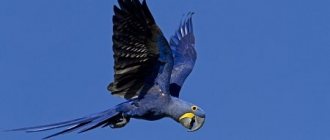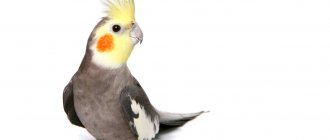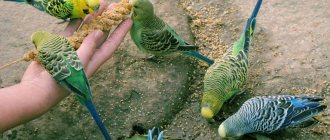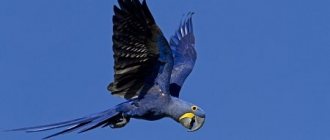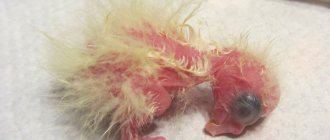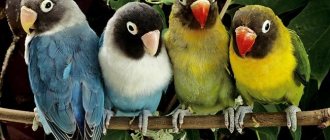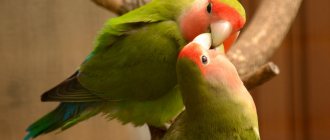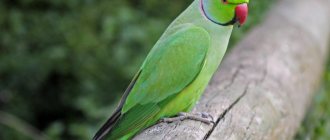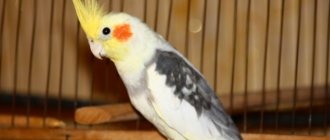Description of song parrots
Song parrots, as a rule, are small in size with a body length of 26-28 cm. But at the same time they have a long stepped tail from 12 to 14 cm in length. The legs are pale pink, the beak is graphite. The feathers are quite bright, which is what attracts song parrots.
By external characteristics you can easily distinguish a male from a female. The bright bird is the male, since to preserve the population the female must be the least attractive.
The male's belly is bright yellow, the back, head, breast and tail coverts are green. This species has one peculiarity - there is a reddish spot at the bottom of the back. The wings themselves are green with yellowish spots and bright blue edges.
The females are mostly gray and have the dullest colors in their feathers, but are no less beautiful.
As a result of selective measures, a new subspecies of song parrots with pastel and bright yellow feathers was obtained.
The genus of song parrots consists of 5 species:
- Yellow-winged (golden-shouldered) or Queensland parrot (lat. Psephotus chrysopterygius).
- Paradise parrot. Belongs to an extinct species (lat. Psephotus pulcherrimus).
- Hooded species (lat. Psephotus dissimilis).
- Red-backed bird (lat. Psephotus haematonotus).
- Multicolored or variegated (lat. Psephotus varius) parrot.
Many experts also included the Blood-bellied Red-tailed Parrot in this genus of parrots, but currently it belongs to the genus Notthiella.
Description of the Blood-bellied Red-tailed Warbler
This species of parrot consists of 4 subspecies:
- Blue-faced Parrot (Psephotus haematogaster haematogaster).
- Red-bellied bird (Psephotus haematogaster haematorrhous).
- Psephotus haematogaster narethae.
- Dull Red-tailed Parakeet (Psephotus haematogaster pallescens).
The color of the plumage of these birds is quite funny - the body is brown, marsh shades, the lower part of the abdomen, and the undertail are of a bright yellow hue. The middle of the tummy and thighs are red. The shoulders and bottom of the tail are blue, and the flight feathers and coverts are purple.
The front part of the head, the frontal part, and the ears are of a bright lilac and violet hue. The eyes are light brown, there is a grayish ring around the eyes, and the beak is gray.
Sexual differentiation is expressed in the color of the feathers - the bright purple and red feathers of males are bright, while those of females are duller. In addition, males look much larger than females, their head and beak are more powerful.
Red-tailed warblers, although attractive, are not at all suitable for keeping at home. To be more precise, favorable conditions for them can only be created by professional and experienced breeders.
If you decide to have such parrots, then keep in mind that there should be no other animals and birds in your house, or you must set up a separate aviary for keeping song parrots. This is necessary because this species has become famous for its excessive aggression towards other animals and birds.
There have been cases of these birds attacking large parrots and even domestic animals. In this case, an attack by blue-faced parrots can result in serious injuries and even death for another animal. Blue-faced birds are, in principle, considered fighters. So do not underestimate their complex nature; as long as song parrots live, they will defend their territory.
Nutrition
The diet of these bright parrots consists of 3 parts of juicy food and 2 parts of grain mixtures. Therefore, there should be two bowls in the cage - with grain food and a juicy mixture.
Variegated rosella
Rosellas also love twig bark, sepia and crushed eggshells.
Recommendations for choosing grain feed:
- There is no need to take grain mixtures by weight - their composition may differ from what is stated, and it is also easier for insects to penetrate there.
- A good bird food should contain canary seed, 2 or 3 types of millet and oats.
- Let's say it contains sesame and hemp.
- There should be very few or no sunflower seeds.
- No colored granules, sugar or preservatives are allowed.
Recommendations for choosing a succulent part of the diet:
All vegetables, fruits and berries that can be given to a bird must be given only without seeds! Exceptions are listed below.
What is possible?
- Citrus fruits - grapefruits, tangerines, oranges.
- Apples, pears
- All red berries, plus blueberries and blueberries
- Peaches, apricots, plums
- A pineapple
- Bananas
- Kiwi
- Quince
- Vegetables: zucchini, pumpkin, Chinese cabbage, beets, tomatoes, cucumbers, turnips, rutabaga, sweet peppers.
Mango and papaya are contraindicated for rosella fruits.
Give viburnum from berries with caution, and only if your pet does not have kidney problems.
Melon and watermelon are not recommended due to frequent cases of poisoning even people.
Zucchini, pumpkin, and lime can be given with seeds.
Fruits and vegetables with thick skins must be peeled first. But if the fruit is grown with your own hands without chemical treatment, you can give it like that, the bird will thank you for the delicious peel.
Beets, kohlrabi, green peas, beans, turnips must be chopped and added in small quantities to the juicy mixture.
Corn - no more than a quarter of an ear and, as an option, hang it in a cage as a tasty toy.
You can pamper your birds with dried fruits without sugar - dried apricots, raisins, dates will appeal to these birds. But it is important that dried fruits are prepared at home; store-bought ones contain preservatives that are harmful to rosella.
Rosellas even eat greens - lettuce, plantain, dandelion from the forest.
Yellow-cheeked rosella
From such a rich variety of permitted diet, it is not difficult to create a menu for a parrot consisting of 5-10 types of succulent food.
The main thing is not to suddenly switch the bird from one diet to another to avoid digestive problems. Every day you can replace a small part of the feeders.
Habitat
Native habitat is south-eastern Australia. They live in natural and human-modified landscapes with a predominance of certain groups of trees and shrubs. They can often live close to humans and build nests in their buildings (in barns, attics).
Parrots live in large flocks, and during nesting they are divided into pairs, while aggressively defending and defending their territory.
During the day, birds look for small insects, feed on berries, plant seeds and even particles of sand.
The song parrot would have been brought to Europe in the mid-19th century.
What should a cell be like?
Budgerigars are small birds, so a family cage does not need to be very large. One pair will comfortably fit in a structure measuring 80/60/40 cm; for two pairs the parameters are multiplied by two. Breeders who have started breeding parrots combine several birds in spacious enclosures. It is recommended to place each family separately so that there are no quarrels between them. While incubating eggs, the female needs rest.
A nesting house - a nest box - is attached to the side wall of the cage. You can hang the house inside the cage, but then its useful volume will be reduced. It’s easy to make a nesting box yourself from several planks or buy it at a pet store. For ease of observation and cleaning, the nest cover should be removable or hinged. The female does not build a cozy nest out of twigs, but peels and drags twigs inside the house. You can make her task easier by placing sawdust mixed with dried chamomile in the cage.
Character of parrots
These birds are quite hardy, have a melodic voice and do not emit sharp cries. Their advantage is that they do not have the habit of constantly gnawing on something. They do not require a huge amount of branches, and they will not at all encroach on your furniture in order to chew it. At the same time, they love to enjoy water procedures. So be sure to give them a bath with clean water, and also spray them with a spray bottle.
The only thing you need to take into account if you decide to have this bird at home is that they are aggressive towards their relatives living in the same cage; they will certainly have constant conflicts over leadership over territory.
How long do song parrots live?
How long song parrots live depends on the individual characteristics of the bird’s body, genetic predisposition and conditions of detention. For this reason, the lifespan of birds varies from 15 to 25 years.
Formation of a marriage union
Before you start breeding parrots, you need to remember that these are flocking birds. The breeder brings together several parrots of different sexes in one room, giving them the right to choose the object of affection. A budgie entering childbearing season must go through all stages of courtship, starting from meeting its partner.
Pairing rules:
- Healthy, strong offspring are possible only from parents without blood ties. Inbreeding leads to the appearance of weakened chicks with congenital anomalies. Sick birds with bad heredity do not live long.
- You cannot force a partner on your parrot. Forced marriage can be fruitless. It is better if the newlyweds choose each other themselves, then the offspring of the loving couple will appear soon.
- The suitable age for mating is one and a half years for females and one year for males. Budgerigars reach high fertility indicators at the age of two to four years. They do not lose their ability to reproduce until they are eight to nine years old. Older birds are not suitable for breeding.
- Females usually choose their own “spouse” and subsequently dominate. Experts advise placing a young female with an experienced male who has already established himself as a father. Then, as she grows up, the girl will not show a quarrelsome character, but will learn to obey her partner.
Attention! Birds that are obese, malnourished or during molting are not allowed to mate.
Song parrot: maintenance and care
These birds have long been domesticated by humans, which means they feel good in captivity. They are small, so they require a small cage, sometimes a cage up to 1 m is enough. But if you decide to buy a pair of song parrots for breeding, it is better to make an aviary up to 3 meters long.
Also take care of the drinking bowl, feeders, developmental elements - ladders, perches, etc. A nesting wooden house up to 30 cm in height is required. The bottom of the house can be covered with wet sand and sawdust; the layer thickness should be about 2-3 cm. This is where the birds hatch their chicks. It is also necessary to fill the bottom of the cage or aviary with sand, since birds spend a large amount of time (if we take into account their habitat in the wild) on the surface of the earth, so they will feel more comfortable.
Best period for breeding
In wild budgerigars living in Australia, the instinct of procreation manifests itself in winter (in the southern hemisphere this is June - August, the rainy season). Domesticated birds are not so tied to a specific time of year; the breeding period is chosen by breeders.
It is better to stimulate the breeding instinct of budgerigars during the summer months. Warmth and long daylight hours promote the production of sex hormones. Our winter and spring are not suitable for pimping, as the birds’ bodies are weakened. The chances of healthy offspring are slim.
Preparation of birds includes a set of actions aimed at improving their health and living conditions:
- increasing the duration of daylight up to 16 hours (adding gradually, 1 - 2 hours a day), turning on additional lighting;
- maintaining the air temperature at least 22 degrees;
- adding mineral elements (calcium, phosphorus) and vitamins to the diet.
An intermediate stage of preparatory activities is hanging the nesting house. Having seen the future “maternity hospital”, the female begins to intensively settle in it - to nest.
Note: a smart breeder plans the nesting of parrots, taking into account his workload. The time of incubation of eggs and feeding of chicks is a busy time when birds require round-the-clock supervision.
What to feed a song parrot
These birds are very picky, so you won’t have to constantly worry about what to feed your song parrot. The standard diet that is used to feed small parrots suits them well.
Their menu may include oats, buckwheat, millet, canary seed, sunflower seeds, sprouted millet, boiled corn, fruits, fresh herbs, and berries.
If the female feeds the chicks, then it is necessary to enrich the diet with food of animal origin - eggs, cottage cheese, and also give more greens and sprouted grains.
Song parrots will not refuse carrots, apples, pears, bananas and pomegranates. You can give flowering branches of some trees or shrubs.
It is interesting that these parrots take such meadow plants as dandelion leaves and dry plantain seeds as a delicacy.
Male courtship
When a budgie decides on the object of its love, it begins to actively court. Strives to constantly be close to the female, polishes feathers, feeds her. In a fit of tenderness, he covers his lady with his wing, looks into her eyes, and nods his head. A male in love coos and dances, taps surrounding objects with his beak - displays.
If the female accepts the suitor favorably, she participates in his dances and responds to his kisses. Some females do not even take food on their own, waiting for the male to pass the treat from beak to beak. The most intimate process happens quickly and unnoticed by prying eyes. Mating games last for several days and even weeks, but sometimes one mating is enough for parrots to achieve fertilization. Next comes nesting time: the mystery of the birth of chicks.
How many days to expect chicks?
As soon as the first eggs are laid, the female should immediately begin to hatch them. The male does not take part in this; his role is to bring food closer to his partner. The bird turns the eggs to ensure even heating. Sometimes it leaves the nest to drink and empty its bowels. In a few minutes, the eggs do not have time to cool down; a slight drop in temperature does not harm the embryos.
The normal hatching time for chicks is 18 days. After the time allotted by nature has passed, the chick breaks the shell from the inside with its beak and gets out. The female helps the cub to free itself and sometimes eats the shell. To prevent the newborn from sticking its skin to the shell, you need to maintain the air humidity in the room at 60%.
After the first baby hatches, remove soaked grains from the new mother’s diet. Remove the empty shells from the house with care, but do not touch the babies. Having sensed a foreign smell on the chicks, the bird may abandon them or show aggression.
Why are eggs infertile?
At the end of the incubation period, whole eggs sometimes remain in the nest. The female continues to hatch them, but she already has a lot of trouble with the newborn chicks. Eggs that have lain in the nest for more than three weeks are most likely useless and should be taken from the mother. Either the embryos stopped developing in them, or fertilization did not occur initially.
Why does it happen that chicks do not hatch from eggs? Causes of defective eggs:
- inexperience of the female, inability to evenly warm the entire clutch;
- genetic diseases;
- poor nutrition in preparation for the nesting period;
- infection in a female;
- unsuitable indoor microclimate.
One or two eggs left unbroken in the nest is normal. A high percentage of unfertilized eggs indicates problems in a pair of parrots. You can find out in advance about the quality of laid eggs using an ovoscope. After checking the condition of the embryos with the device, empty eggs must be removed from the clutch.
The result in breeding budgies depends on the level of knowledge and experience of the breeder. Preliminary preparation, good condition of the birds and close observation are the main components for obtaining healthy offspring.


